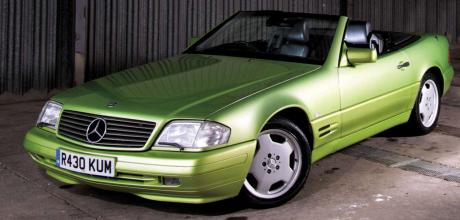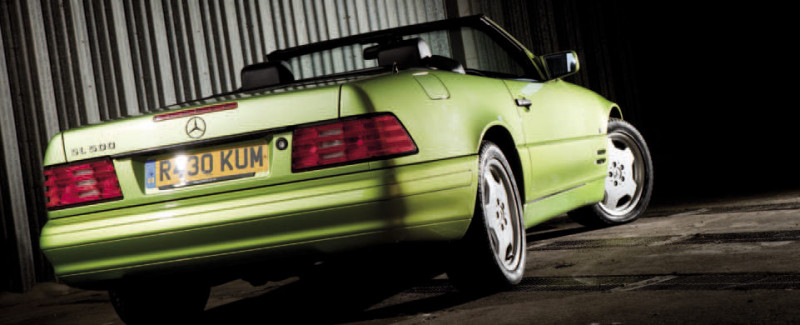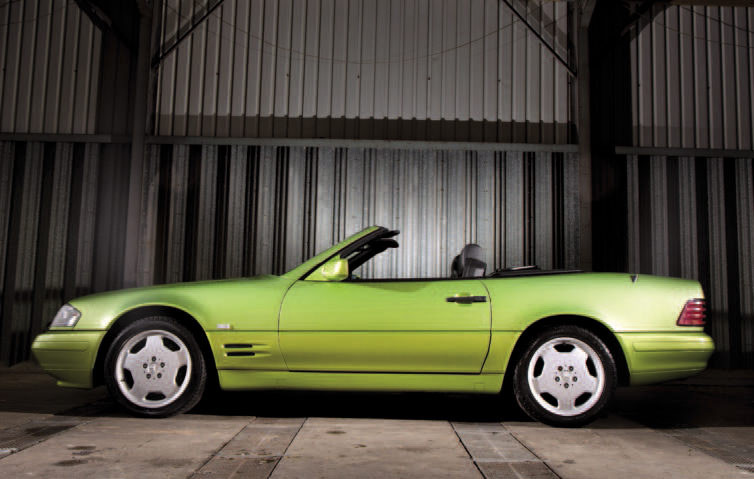Buyer’s Guide M119 V8-engined Mercedes-Benz 500SL/SL500 R129

The M119 V8-powered SLs from the 129-series are among the greatest modern classic buys for those on a reasonable budget, combining robust quality with effortless performance and high-end cabin appointments. Words David Sutherland. Images Eric Richardson.
Buyer’s Guide
M119 V8-engined R129 500SL/SL500 models
The R129 generation of the SL could hardly have been more different from the R107 it replaced in late 1989, a model that had been around for 18 years and as a result had come to look and feel old fashioned even if its charisma and customer appeal were undiminished. Whereas the R107, designed in the 1960s, relied on simple, electronics-free mechanicals, everything about its successor was state-of-the-art, from the trick suspension to the incredible pop-up rollover protection system.

But the classic car market can be fickle, and while the R107 has enjoyed collector status from the day it was discontinued over 30 years ago, the R129 has not commanded the same respect. For years after it was replaced in 2001, its values were on the floor, making it by far the cheapest SL you could buy and risking it becoming the ‘throwaway’ SL. Of late, though, R129s – at least those in respectable condition – have begun to creep up in price as the market re-evaluates them, and now values generally exceed those of early R230 SLs, the model that replaced it. Furthermore, preferences are developing on particular models. Where previously the 1993 to 1998 SL60 AMG (and unicorn-esque SL70/73 cars) was the only model that fetched any real price premium, the early and mid-cycle 500s have been identified as a good model to bag, due to their motor being the four-valves-per-cylinder, five-litre M119 V8 as opposed to the later M113 three-valver.
So here we focus on these SLs, built from the start of production until the spring of 1998. Has Mercedes’ traditional build quality been enough to sustain these complex motorcars, or are they little more than wallet-trashing liabilities?
Design & evolution
The R129, the sixth model to bear the hallowed Sport Leicht badge, was unveiled at the Geneva motor show in March 1989, and unsurprisingly was the star of the show. The R107’s classic elegance was replaced by a subtle powerhouse look, emphasised by bodywork bereft of chrome apart from the star on the grille and the model badging. Stuttgart legitimately billed it ‘a technical showcase’ and claimed nothing was shared by the two model generations apart from their 2+2 convertible configuration.
In September 1992, the 500SL R129 engine switched from Bosch KE-Jetronic to Bosch LH-Jetronic fuel injection
The flagship was the 500SL, and with this model Mercedes broke a tradition of launching a new car with engines from its predecessor. Gone was the R107 500SL’s two-valve M117 five-litre V8, replaced with the all-new M119 of the same capacity, featuring multi-valve cylinder-heads and inlet camshaft adjustment. Output was 322bhp plus 332lb ft at 4,000rpm, increases of 33 and 15 per cent over the R107 500SL. The 500SL was accompanied by the three-litre 300SL, which did carry over a previous engine, the two-valve M104 unit, and the four-valve 300SL-24.

A four-speed automatic gearbox (with ‘Standard’ and ‘Economy’ settings) was fitted as standard to the 500SL. At that point, Mercedes had just come up with the world’s first production five-speed automatic, but it was made available only on the 300SL-24.
A new generation acceleration skid control, ASR, was present to warn of and prevent the rear wheels breaking traction, along with ADS, the adaptive damping system that trims the shock absorber stiffness according to road surface quality and road speed. It also incorporated self-levelling; both however were expensive options in the UK in 1989, ASR £1,800 and ADS £2,900.
As on previous SLs, the hood was stowed beneath a neat metal cover, but was electrically powered for the first time on an SL-Class (17 switches, 15 pressure cylinders and 11 magnetic valves), while a new device called a windbreak made its first appearance. The cabin bristled with electric motors, to move the steering wheel, the seats, the seat belt tensioners (built into the seat), even the rear-view mirror.
But the cleverest trick of all had to be the pop-up rollover protection system – a significant innovation by Mercedes, which for the first time saw occupants of a fully open car given substantial protection in the event of a roll. Reportedly taking four years and over £8m to develop, a U-shaped bar pops up in 0.3 seconds should sensors monitoring suspension behaviour and the angle of the car to the road anticipate a possible rollover.
When the 500SL went on sale in the UK in autumn 1989 it was priced at £58,000, the second most expensive Mercedes after the 560SEC at £63,000. Leather seats with electrical memory adjustment were included, but if you wanted air conditioning that was another £2,000, driver and passenger airbags £2,200, seat heaters £365 and cruise control £307. And the factory radio equipment list was interesting: a Becker radio/cassette was £1,200 and if a CD player was incorporated the price rose to £2,700! But long queues of customers developed, all paying full list price.
In September 1992, the 500SL engine switched from Bosch KE-Jetronic to Bosch LH-Jetronic fuel injection; in the interests of low exhaust emissions, this no longer featured a richer fuel mix under full throttle, hence maximum power dropped slightly, to 316bhp, although peak torque increased to 347lb ft, occurring 100rpm lower.
In June 1993, the R129 (along with all other Mercedes cars) changed its model badging, with the numbers and letters reversed, the 500SL becoming the SL500. And after six years, in September 1995, the R129 received the first of its two facelifts. Visually, the changes were low key, limited to new wheels and colour-keyed exterior trim and some tweaks in the cabin, but there were significant engineering updates including a new coil pack ignition system and a five-speed electronically controlled automatic gearbox for the SL500, while Brake Assist and ESP traction control were fitted. A glass topped roof became available, and this spec continued until April 1998 when, at the R129’s second facelift, the SL500 switched to the dual ignition, three-valve M113 V8 (302bhp/339lb ft).
Driving the 500SL
The M119 V8 will go down as one of Mercedes’ best ever engines: it has the same silky refinement as the preceding M117, but a lot more top-end urgency.
Notwithstanding the SL60 AMG, many reckon the five-litre V8 is the choice for the R129, as smooth as the V12 but with more character and certainly not wanting in performance. It’s a lovely motor to use, making the 500SL/SL500 a supremely relaxed drive. As for the transmission, the five-speed auto fitted in 1995-on cars is nice to have but doesn’t fundamentally alter the feel of this roadster.
Inside, the R129 retains the old school Mercedes style. The cabin furnishings are solid and well made, and the contrasting walnut veneer and plastic trim combination has a superior look and feel. The hood, though, is too old fashioned, with exposed metal stays inside, and it was disappointing that when you got a glass rear screen on a VW Golf convertible, the SL item was plastic.
What you’ll pay
All change here. Just a few years ago early 500SL/SL500s filled the bargain basement classifieds, but now you won’t find many under £10,000. They’re still being offered for sale – but as classics, not cheap old Mercs.
At the time of writing, there were plenty examples advertised online by dealers, ranging from £18,500 for a 1995 SL500 with 86,000 miles to £29,500 for an early, 1989/G in classic Almandine Red with just 32,000 miles. The top prices are likely to be charged by the established classic Mercedes specialists; SL Shop in Warwickshire, for example, asked £39,995 for a late, 1997 24-valve with 24,000 miles. However, the cheap R129 still exists if you look for it, such as the privately offered, £6,995 1995 500SL near Sheffield with a sad looking hood and 114,000 – or possibly more – miles showing on the odometer.
500SL/SL500 Inside and out
Powertrain
Engines from 1993 onwards used Mercedes’ infamous ‘biodegradable’ wiring loom. Due to the heat, this disintegrates in the main loom (and also in the separate loom in the throttle body mounted inside the vee of the engine) and causes misfiring.
● 500s from before September 1995 had twin ignition rotors (one on each cylinder bank) and their caps are prone to condensation build-up in cold weather, which not only results in fluffy engine running but can irreparably damage the caps. The subsequent coil pack M119s are unaffected.
● A ’tappety’ sounding engine is almost certainly due to the plastic oil supply tubes to the tappets losing pressure and becoming incapable of delivering oil. If left in this state, the oil-starved tappets will wear to the point where they all need replacing. Later oil pipes were metal and more durable.
● The five-speed gearbox is generally as reliable as the four-speed, and any shifting problems are more often than not a result of skimped gearbox servicing.
Magic Eyes Ultramarine trim from the exclusive designo catalogue.
Specialist overview
Bruce Greetham of SL Shop, Warwickshire
“The R129 is a reliable car and the M119 is one of the best engines Mercedes has ever made. The sweet spot is 1996 to 1998, the last of the M119s before the M113 came in, when they were really sorted. These are the best R129s in their pure form.
“The engine only has only two common issues, the wiring loom and condensation in the distributor caps of the early engines. The four-speed gearboxes are supposed to be more robust than the five-speeds, but I’ve never had problems with the five-speed automatic.”
Suspension, steering and braking system
● On cars with the optional adaptive damping, take particular note of the ride quality – if almost rock hard, the suspension spheres may be faulty.
● Check for noises and clunks from the front suspension – worn lower ball joints can cause a creaking noise.
● Steering precision can be affected by play in the track rod ends, and by leaks from the steering box and the steering damper.
● The brake pipes can rust where they pass over the top of the rear subframe, and the rubber brake hoses perish. And if an R129 is used infrequently, the discs become covered in surface rust, and the rear ones in particular suffer in this respect, due to there being less braking force to clear it.
Designo Light Green paintwork; the R129 SL is 4.5m long and 1.8m wide.
Bodywork and wheels
● The R129 resists corrosion impressively, but the sheer age of the car takes its toll. Check the front wings above where the wing joins the bumper, below the indicator, and also inspect the rear wings. Other areas known to rust are the tops of the suspension mounts, and the front valance below the front bumper and around the boot lock.
● Examine the metal hardtop which came with every R129, and don’t be surprised if there is some bubbling of the metal at the bottom of the pillars, where it meets the car’s bodywork.
● The three plastic windows in the hood can harden, crack or turn opaque with age. The only cures are replacement windows or a new hood, both expensive options.
The R129 is a reliable car and the M119 is one of the best engines Mercedes has ever made M-B made 79,827 500SL/ SL500s with M119 V8; 17s standard from 1998.
Interior and electrics
● The air conditioning should be checked for efficient operation; normally a non-functioning system means a leak, usually from the condenser.
● Hood operation should be smooth, because at this age the many sensors and micro switches can play up. Electrical fault finding on early 500SLs can be difficult and time consuming, as they do not communicate so well with diagnostic equipment.
● The rollover bar, which can be raised by a switch on the dash, should also go up and down smoothly.
● All electrics should be tested thoroughly, electric memory seats being a common failure. A new control module under the seat is required. Airbags and rollover protection included; the R129 SL-Class is a 2+2.
Verdict
Aside from early R230s, the R129 is the only SL available for affordable money; even the very, very best five-litre V8s come at under £40,000, way less than a pristine R107 or W113 Pagoda. The ‘problem’ for many prospective SL purchases is, of course, the styling, which is quite bland compared to that of other SLs. That’s ironic, because based on the driving experience alone, the R129 is arguably a vastly superior car to its predecessor.
But this sentiment leaves the R129, and particularly the M119-engined 500SL/ SL500 something of an undiscovered treasure. For £20,000 you’ll get a wonderfully well built, comfortable Mercedes-Benz roadster that is fast and refined, and still modern enough for everyday driving. What’s not to like?
M119 vs M113
We restricted this Buyer’s Guide to the M119-engined 500s, but what’s the difference between that engine and the M113 V8, which went into the SL500 in 1998 for the last three years of production? The M113 switched from four- to three-valve cylinderheads and twin spark plugs, and power and torque decreased slightly – and this was enough to give the M113 car a different character, according to Bruce Greetham of Warwickshire-based SL Shop.
“The M113 is more fuel efficient and cleaner, but it makes the car feel clinical,” he insists. “You’ve got to rev it harder to get the torque, and it has lost that edge the M119 has. You could say it’s better but less enjoyable.” Bruce also feels that the other changes implemented in the 1998 facelift altered the SL500’s feel. “You had nappa leather, fold-in mirrors, and overall it feels softer and more modern. If you’re purist, you want a 1996 to 1998 M119-engined car.”
Typical basic servicing costs (A/B services including VAT)
MODEL OIL SERVICE MAJOR SERVICE 500SL/SL500 £213 £1,424
Quotes from SL Shop
Non routine servicing costs
★ Gearbox oil change £396
★ Fit front brake discs and pads £531
★ Fit two new ignition distributor caps £573
★ Renew the engine and throttle body wiring looms £3,051
★ Replace the lower front suspension arm ball joints and bushes (pair) £1,738
★ Four premium brand tyres (225/55ZR16) £600
500SL/SL500 timeline
● October 1989 UK sales of the 500SL (and 300SL/300SL-24) commence
● September 1992 The 500SL’s five-litre M119 engine switches from Bosch KE-Jetronic to Bosch LH-Jetronic fuel injection, with a slight loss of power
● June 1993 Under Mercedes-Benz’s new badging policy the R129 500SL is now known as the SL500
● September 1995 The R129 range is facelifted, improvements including a standard-fit five-speed automatic in the SL500
● April 1998 The 32-valve M119 V8 engine is discontinued, the SL500 now using the three-valves-per-cylinder M113 V8
What you’ll pay
£5,000-£10,000 Early 1990s 500SL, with corrosion and little or no service history, and possibly some mechanical issues too £10,000-£15,000 Average condition 500SLs and SL500s with over 100,000 miles, offered privately £15,000-£25,000 Good cars with under 75,000 miles, mostly sold by dealers at this price £25,000-£40,000 Must be an immaculate condition ‘time capsule’ example, with under 40,000 miles on the clock and a full service history record
THE BACK END
Spotted for sale
CLASSIC CAR SPECIALIST
500SL 1992/K, blue, mushroom leather, air conditioning, electric memory seats, 65,500 miles, £18,000, Glasgow
Spotted for sale
PRIVATE SELLER
500SL 1991/H blue, grey leather, ADS, air conditioning, seat heaters, airbag, 56,400 miles, £16,980,
Southampton
Just the facts
Mercedes-Benz 500SL (R129)
- ENGINE M119 4,973cc V8
- MAX POWER 322bhp @ 5,500rpm
- MAX TORQUE 332lb ft @ 4,000rpm
- TRANSMISSION 4-speed auto, RWD
- WEIGHT 1,770kg
- 0-62MPH 6.2sec
- TOP SPEED 155mph
- FUEL CONSUMPTION 17.0mpg
- YEARS PRODUCED 03.1989-08.1992
Mercedes-Benz 500SL/SL500 (R129)
- ENGINE M119 4,973cc V8
- MAX POWER 316bhp @ 5,600rpm
- MAX TORQUE 347lb ft @ 3,900rpm
- TRANSMISSION 4-/5-speed auto, RWD
- WEIGHT 1,800kg
- 0-62MPH 6.5sec
- TOP SPEED 155mph
- FUEL CONSUMPTION 17.7mpg
- YEARS PRODUCED 09.1992-06.1998
All figures from Mercedes-Benz; fuel consumption according to EEC urban; top speed electronically limited; 500SL model known as the SL500 from June 1993; five-speed auto introduced in September 1995

